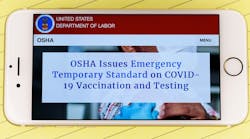Court Blocks and Condemns OSHA's Emergency Temporary Standard as "Staggeringly Overbroad"
ANALYSIS
A three-judge panel of a federal appeals court has not only reaffirmed its temporary restraining order blocking enforcement of the Occupational Safety and Health Administration’s (OSHA) emergency temporary standard (ETS) on COVID-19 vaccination and testing but has also asserted that those opposing it are likely to prevail in overturning it.
After the U.S. Fifth Circuit Court of Appeals stayed the ETS on Nov. 6 one day after it was published, a three-judge panel from the circuit on Nov. 12 issued a 22-page decision filled with quotes and footnotes strongly supporting the legal case mounted by those suing to overturn the order. Plaintiffs include state governments, staffing and other private companies and industry associations.
It may seem odd if you are not well acquainted with how the injunction process works, but before one can be granted, the request must meet several standards, one of which is showing that there is a likelihood the plaintiffs will prevail on the merits of the case. However, in this case the three judges went to extraordinary lengths to come to their conclusion that yes, the likelihood of those suing winning their case is in fact quite strong.
The judges’ written decision also could impact on similar lawsuits brought by opponents of the federal contractor vaccination mandate who have filed their own suits in various courts. They also are seeking injunctions to block that order while it makes its way through the court system.
The cases challenging the contractor rule have followed a similar trajectory to the ones that have been brought against the ETS—multiple plaintiffs bringing actions in court venues across the United States that put forth a variety of legal arguments.
To simplify the process, under federal statute all of the cases challenging the ETS will be consolidated and transferred to one circuit chosen by lottery. A judicial panel drawn from seven circuit and district judges designated by Supreme Court Chief Justice John Roberts will meet on Nov. 16 to choose which appeals court will hear the case.
It is not clear at this point whether those judges’ views will align with those of the Fifth Circuit three-judge panel’s blistering condemnation of the Biden administration’s action that was rendered in no uncertain terms on Nov. 12, but it appears that they would have to engage in equally strenuous disagreement with their judicial colleagues for the ETS to survive judicial scrutiny.
The Fifth Circuit judges point out that in its 50-year history, OSHA has issued just 10 such ETS rules, six of which were challenged in court and only one of which survived. Federal agencies like OSHA normally are expected to impose regulatory burdens only after an extensive and careful process established by federal law, which allows sufficient time for public comment and discussion, as well as addressing the impacts the rule could impose on the environment and on small businesses, before becoming an enforceable regulation.
Because of this, the courts historically have been reluctant to allow OSHA to simply issue decrees that possess the force of law in the form of an ETS which bypass the rulemaking process, even if it is only for a period of six months. In the past, the OSHA regulators had to think twice before issuing a standard when they knew it would come under the unyielding scrutiny of the courts.
Failure to Learn Lessons
A perfect example is the other ETS that President Biden earlier in his administration had ordered OSHA deliver to tell employers how they should deal with COVID prevention and cases in the workplace. That executive order was signed on Jan. 21, the day following Biden’s inauguration, requiring OSHA deliver that ETS no later than mid-March.
But that ETS was not issued until June 10, and the delay was caused by caution concerning how courts would view it at a time when it was widely believed that we had finally gotten a handle on COVID-19.
Keep in mind that at the time it was widely believed by administration officials that the accelerating pace of vaccinations was beginning to end the pandemic. This would have made it impossible for the administration to defend the OSHA ETS in court because it would have to admit that the “emergency” they were intended to address no longer existed.
When that standard did come out, it only applied to workers in the healthcare industry and dealt primarily with the use of facemasks and social distancing, much reduced from the standard sought by unions last year at the height of the pandemic.
The three judges on Nov. 12 said about the new vaccine ETS that, “The mandate’s stated impetus—a purported ‘emergency’ that the entire globe has now endured for nearly two years, and which OSHA itself spent nearly two months responding to—is unavailing as well. And its promulgation grossly exceeds OSHA’s statutory authority.”
Let’s take a look at some of the other things the Fifth Circuit judges found so objectionable about the vaccination ETS that they felt it necessary to block it and believe the plaintiffs eventually will prevail.
They observed that the federal law creating OSHA in 1970 was not and could not be intended under the Constitution “to authorize a workplace safety administration in the deep recesses of the federal bureaucracy to make sweeping pronouncements on matters of public health affecting every member of society in the profoundest of ways.”
The judges went so far as to describe the ETS as “fatally flawed” because its reach extends far beyond the agency’s mission and prescribed powers set by Congress.
“The mandate’s strained prescriptions combine to make it the rare government pronouncement that is both overinclusive (applying to employers and employees in virtually all industries and workplaces in America, with little attempt to account for the obvious differences between the risks facing, say, a security guard on a lonely night shift, and a meatpacker working shoulder to shoulder in a cramped warehouse) and underinclusive (purporting to save employees with 99 or more coworkers from a ‘grave danger’ in the workplace, while making no attempt to shield employees with 98 or fewer coworkers from the very same threat).”
Using OSHA as a Pretext
The judges also took note that the Biden administration had gone to some effort to scour the federal bureaucracy in order to find what the presidential chief-of-staff publicly admitted was a “workaround” to impose some sort of federal vaccine mandate and then settling on the OSHA ETS as their legal weapon to wield.
Instead of being a rarely exercised and carefully wrought measure aimed at addressing a specific, well-defined emergency, “the mandate is a one-size-fits-all sledgehammer that makes hardly any attempt to account for differences in workplaces (and workers) that have more than a little bearing on workers’ varying degrees of susceptibility to the supposedly ‘grave danger’ the mandate purports to address,” the judges held.
They also pointed out that OSHA cannot show that the COVID danger extends to all workplaces or poses an especially grave danger at a time when 81% of the U.S. adult population (18 or older) is estimated to be partially or fully vaccinated. They also took note that even the late AFL-CIO president Richard Trumka, who early on in the pandemic sought an ETS from OSHA, admitted that “OSHA lacks evidence to conclude that all infectious diseases to which employees may be exposed at a workplace constitute a ‘grave danger’ for which an ETS is an appropriate remedy.”
The judges unhesitatingly described the vaccine ETS as “staggeringly overbroad,” because it applies to two-thirds of private-sector employees in widely diverse workplaces. In addition, the mandate fails to consider that COVID-19 is more dangerous to some employees than to others, depending on their locations and the nature of their jobs as well as their immunity status, they said.
The judges also stress that “a naturally immune unvaccinated worker is presumably at less risk than an unvaccinated worker who has never had the virus. The list goes on, but one constant remains—the mandate fails almost completely to address, or even respond to, much of this reality and common sense.”
The injunction also protects the public interest because since the President announced the new ETS was coming in September, “from economic uncertainty to workplace strife, the mere specter of the mandate has contributed to untold economic upheaval in recent months,” the judges explained.
What will be protected by the stay does not just prevent further unnecessary economic losses, the judges declare. “The public interest is also served by maintaining our constitutional structure and maintaining the liberty of individuals to make intensely personal decisions according to their own convictions—even, or perhaps particularly, when those decisions frustrate




